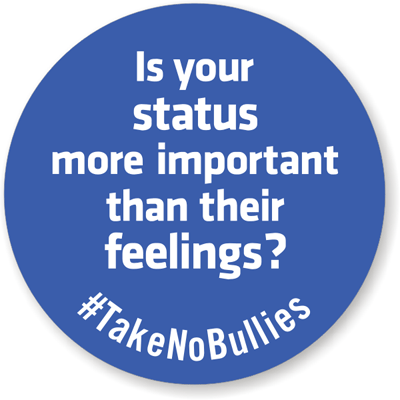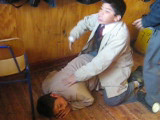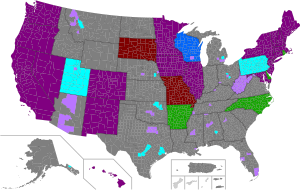|
|
| Some states in the United States have implemented laws to address school bullying. Law prohibits bullying of students based on sexual orientation and gender identity Law prohibits bullying of students based on sexual orientation only School regulation or ethical code for teachers that address bullying of students based on sexual orientation Law prohibits bullying in school but lists no specific categories of protection No statewide law that specifically prohibits bullying in schools (Photo credit: Wikipedia) |
Bullying remains the hottest of hot button issues in special education law. In an earlier installment, I explained the early cases laying the conceptual groundwork for the proposition that failure to react to bullying can constitute a denial of FAPE under IDEA. In the last installment, I discussed the seminal decision of
TK & SK ex rel LK v. New York City Dept of Educ 779 F.Supp.2d 289, 56 IDELR 228 (E.D.N.Y. 4/25/2011). This case is important not just because it analyzes special education law principles involving bullying, but also because it provides a thorough review of the social science literature on bullying. You should read this case and you can do so
here.
In this installment, I begin to review the literature on bullying. Please note the court provided these words in its opinion. I cannot take credit for the analysis:
E. Bullying in America
Were bullying characterized as a disease affecting America's youth, a team from the Center for Disease Control charged with investigating epidemics would have been called in to study it. Joseph L. Wright, Address at American Medical Association Educational Forum on Adolescent Health: Youth Bullying 23 (2002), available at http://www. ama-assn.org/amal/pub/upload/mm/39/youthbullying.pdf. ("If [bullying] were a medical issue, for example an infectious disease in my pediatrics practice, we would have the Epidemic Intelligence Service people from the Centers for Control and Prevention investigate it. The prevalence and epidemiology is striking."). The problem is pervasive; it is perceived by educators as serious, particularly in the middle school years. Michaela Gulemetova, Darrel Drury, and Catherine P. Bradshaw, Findings Form the National Education Association's Nationwide Study of Bullying: Teachers' and Education Support Professionals' Perspectives, in White House Conference on Bullying Prevention, at 11-12 (March 10, 2011), available at http://www. stopbullying.gov/references/white_house_conference/index.html. ("Over 40 percent of [teachers and support staff surveyed] indicated that bullying was a moderate or major problem in their school, with 62 percent indicating that they witnessed two or more incidents of bullying in the last month, while 41 percent witnessed bullying once a week or more."). It is the most common type of violence in our schools. Macklem, supra, at 7.
The issue first seized the attention of the American public after the 1999 shooting at Columbine High School that killed fifteen students and wounded two dozen more. Susan P. Limber, Addressing Youth Bullying Behaviors, in American Medical Association Educational Forum on
Adolescent Health: Youth Bullying 5 (2002), available at http://www.amaassn. org/amal/pub/upload/mm/39/youthbullying. pdf. As part of the investigation that followed the Columbine massacre, the Secret Service examined thirty-seven shooting incidents. They determined that in two-thirds of those cases, the shooter described feeling bullied, persecuted, or threatened at school. Bill Dedman, Secret Service Findings Overturn Stereotypes, Chicago Sun-Times Report, Oct. 15-16, 2000, at 9; Limber, supra, at 5. "I just remember life not being much fun, a shooter recalls. Reject, retard, loser.' I remember stick boy a lot cause I was so thin." Dedman, supra, at 9.
More recently, stories of bullied victims taking their own lives have become common. See, e.g., John Schwartz, Bullying, Suicide and Punishment, N.Y. Times, Oct. 3, 2010, at Al (discussing the suicides of three teens as a result of online bullying); Limber, supra, at 5 (noting that internationally the study of bullying was triggered by the suicides of three young boys in Norway in the 1980s). Some one third of students are engaging in aggressive behavior directed at their peers, oftentimes with the goal of increasing their popularity. Tara Parker-Pope, Web of Popularity, Achieved by Bullying, N.Y. Times blog, (Feb. 14, 2011, 5:03 p.m.), available at http://well.blogs.nytimes.com/2011/02/14/ web-of-popularity-weaved-bybullying/' scp=1&sq=Tara% 20ParkerPope% 20bully&st=cse.
National leaders and educators continue to work toward a solution. President Obama held a summit and announced new federal programs that aimed at "dispel[ing] the myth that bullying is just a harmless rite of passage or inevitable part of growing up." Jackie Calmes, Obama Focuses on Antibullying Efforts,N.Y. Times, March 10, 2011, at A18.
Presidential summits and school shootings achieve headlines, but the day-to-day adverse affects of bullying in damaging educational opportunities to students are as real as they are unnoticed. It is a problem that affects the school performance, emotional well-being, mental health, and social development of school children throughout the United States. Tonja R. Nansel et. al., Cross-national Consistency in the Relationship Between Bullying Behaviors and Psychosocial Adjustment, 158 Archive of Pediatric and Adolescent Med. 730, 733-35 (2004). Whether a child is the victim, aggressor, or merely a bystander, research shows that those in a close vicinity to bullying are adversely marked. Id. See also, Macklem, supra, at 44, 90-92.





























